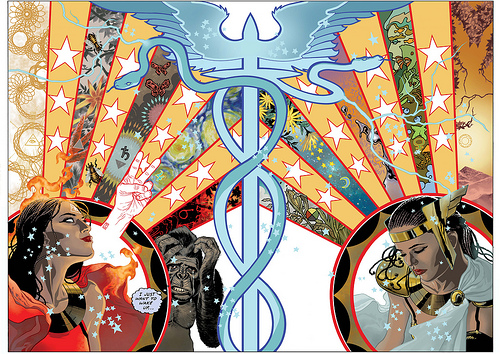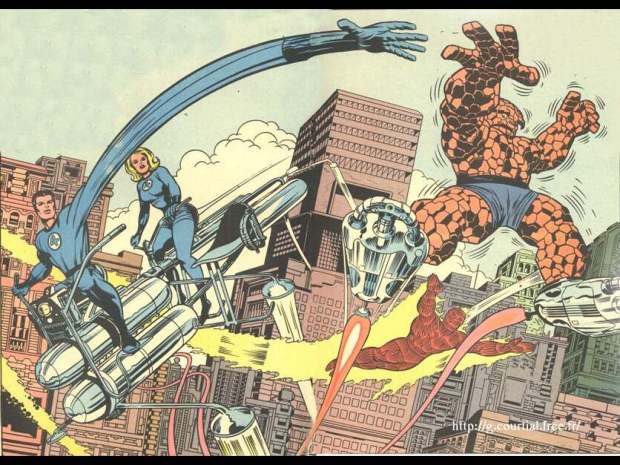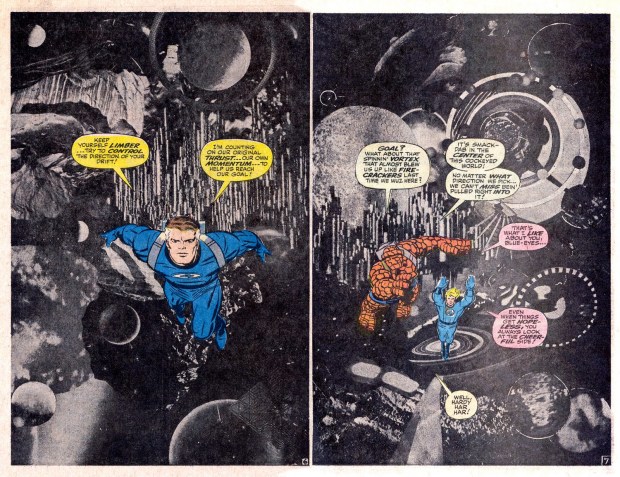It’s back!! Practitioners, our weekly article featuring the people who made the comics industry, went on a three month away day while we continued to complete Moon but it’s now back!! Practitioners will now be bi-weekly, while every second week on Tuesday Practitioners Reloaded will present the previous 1 – 53 (Simon Bisley – Chris Bachalo) and then continue to showcase all the new articles until we’ve written a comprehensive history of the comic book industry!! Or die.
James ‘Jim’ H. Williams III, usually credited as J.H. Williams III, is a comic book artist and a penciller, best known for his work on titles such as Promethea (with Alan Moore), Desolation Jones (with Warren Ellis) and Batwoman (with W. Haden Blackman).
J H Williams is a master of his art and others aside. Most Practitioners have a near-complete grasp of the comics page, panel to panel storytelling, placement and composition. Most pages produced for comic books are purpose built as little more than a rendition of a writers words and descriptions. J H Williams III limits himself to nothing, challenging himself to extrapolate only the most complex compositions in the history of comics without losing control of plotting, pacing or flow. Bleeding edge double page spreads, multiple styles and techniques combining into both unique and familiar page styles. Able to mimic the most prominent and recognisable legends in comic book history, while able to seamlessly drop into his more comfortable naturalistic style, Williams has defined himself as a master draftsman and a timeless artist.
 Williams’ early work includes pencilling the four-issue miniseries, Deathwish (1994-1995) from Milestone Media, a company founded to present a platform for characters of ethnic minority, the most famous of these Hardware, Icon, Blood Syndicate and Static. Deathwish – tag line: ‘Paint the Town Dead’ – was a dark number, featuring Wilton Johnson, the victim of a brutal family raping from which only he survived. Appearing in Hardware six times, the series was notable for it’s use of a pre op transexual, obsessed with sex related crimes, as it’s protagonist. It also featured the exclamation ‘Fuck art! Let’s dance!’ at the close of the third issue. This was a dark and distinctive introduction to comics for J H, the artwork visceral, savagely brutal, anarchic and powerfully emotive, Deathwish presented as a damaged, frightening and unpredictable figure – rendered powerful with extremely tight line work from Williams. It’s hard to imagine a more fringe entrance to the popular comics industry but JH held nothing back and presented himself as a strong contender. Written by Adam Blaustein, Deathwish has disappeared into the murky comic book back catalogue but JH Williams III was to plough on to handle some of the most challenging and venerated comics in the industry (most often thanks to his art work). It also gave Williams the chance to work with legendary inker and Joe Quesada partner, Jimmy Palmiotti.
Williams’ early work includes pencilling the four-issue miniseries, Deathwish (1994-1995) from Milestone Media, a company founded to present a platform for characters of ethnic minority, the most famous of these Hardware, Icon, Blood Syndicate and Static. Deathwish – tag line: ‘Paint the Town Dead’ – was a dark number, featuring Wilton Johnson, the victim of a brutal family raping from which only he survived. Appearing in Hardware six times, the series was notable for it’s use of a pre op transexual, obsessed with sex related crimes, as it’s protagonist. It also featured the exclamation ‘Fuck art! Let’s dance!’ at the close of the third issue. This was a dark and distinctive introduction to comics for J H, the artwork visceral, savagely brutal, anarchic and powerfully emotive, Deathwish presented as a damaged, frightening and unpredictable figure – rendered powerful with extremely tight line work from Williams. It’s hard to imagine a more fringe entrance to the popular comics industry but JH held nothing back and presented himself as a strong contender. Written by Adam Blaustein, Deathwish has disappeared into the murky comic book back catalogue but JH Williams III was to plough on to handle some of the most challenging and venerated comics in the industry (most often thanks to his art work). It also gave Williams the chance to work with legendary inker and Joe Quesada partner, Jimmy Palmiotti.
But it was on the short-lived 10-issue (including a special 1,000,000 issue) Chase title, with writer Dan Curtis Johnson that he came to prominence. Based on a character, Cameron Chase, that appeared in Batman #550 in January 1998, it followed Chase as an agent of the Department of Extranormal Operations tasked with monitoring and neutralising Metahuman threats to national security. The blend of the extreme metahumans and the noirish, dark edged naturalism made Chase a moderate hit for fans of fine comic art, J H Williams’ involvement perhaps elongating the short run. Never the less, it was here that J H Williams entered the DC firmament and began to make creative ripples throughout the industry.
Even then, at the start of his main career, J H Williams III demonstrated all of the skills that have made him a watchword for both wild experimentation and paradoxically professional reliability of quality. Every page bled with the precise representation of the writer’s ideas somehow locked seamlessly between naturalism and comic book fantasy. Anchoring the content with a powerful grasp of expression, anatomy, light and composition, JH Williams III draws in the reader, pacifying their expectations with beautifully accessible detail while introducing dizzying and brave compositions.
Williams collaborated with inker Mick Gray on two DC Elseworlds graphic novels, Justice Riders – in which the Justice League of America are recast as western figures – written by Chuck Dixon and Son of Superman, written by Howard Chaykin and David Tischman. Justice Riders would likely inform Williams’ interest in drawing wild west heroes, as they appear again in the later Seven Soldier’s series bookends (written by Grant Morrison) and a single issue of Jonah Hex (#35) on which Williams said “I certainly want to do more issues myself or even a graphic novel if the opportunity and schedule presented itself.”
It was with another of DC’s most famous writers – the legendary Alan Moore – that JH Williams was to find yet greater prominence, both as an interior and cover artist, with the utterly glorious Promethea (32 issues, 1999–2005). It was here that Williams’ now legendary capacity to twist the logic of a comic book page really took hold. Taking first of all the poetic and holistic plots and scripts of Mr. Moore, JH Williams treated every page (or double page) as single images, and rather than simply breaking them into neatly compartmentalised shot boxes, expanded the use of the form in a way most artists would never think to. Some panels were simply single figures occupying space centrally in the page, events, language and conversations rotate around specific images at the heart of the image, where panel work took place in more conventional ways, large, iconic panels drew the scene effortlessly across the top of a double page spread, making the remaining panels parts of that larger image. A dramatic understanding of fable, fantasy, ancient historical and the art nouveau style of Alphonse Mucha, popular with other legendary artists such as Joe Quesada and Adam Hughes, permeates the indelible world of Promethea. Notably, it wasn’t Moore that walked away with as many accolades as Williams, Moore taking considerable criticism at the suggestion that Promethea was acting as a mouthpiece for his religious beliefs while praise was heaped on the series for the beauty of it’s artwork and innovation regarding the medium itself. It is there that Williams excels, breaking tradition and standards perhaps unitentionally layed down at the birth of early comic books and again indirectly cemented by the unquestionable work of Kirby, Ditko, Gibbons – even Otomo through the popularity of their work.
But Williams isn’t trying to change the industry. His work isn’t a clarion call to other artists to try to do the same. Should too many try, comics would most likely become a chaotic mess. Williams’ work is innate and personal to him, a style and level of detail and naturalism that comes from pure, raw talent. His work is a treat. His is the Art Deco print amongst the Metallica posters. It flatters the owner and offers a beautiful and enlightening alternative to the great and beloved standard.
Detective Comics with writer Greg Rucka gave birth to the series that will leave JH Williams III in the upper echelons of comics practitioners. In the wake of the loss of the title character, ‘Detective’ Batman was absent in the aftermath of Batman R.I.P. and Final Crisis, causing the title to focus on Rucka’s Batwoman. Williams has returned as an artist and now writer of the new Batwoman series, accompanied by co-author W. Haden Blackman. Using all of the talents and skills from his previous work, Williams has formed a title of delicate and volatile beauty. Batwoman, shock of sharp red hair and porcelain white skin, is an even more distinct figure perhaps than Clark Kent when not Superman, and should be easily recognisable in the bat suit as the only person in Gotham with no pigment on their skin. None of this matters though, as a languishing presence of a child-stealing spirit of a bereaved mother haunts the waterways of Gotham. Blending dizzying but easily maneouvrable double page spreads with fine art, profound expressionism, watercolour, pencil line, ink and hand drawn finishes entwined with a haunting, feminine and original story line, Batwoman ticks a lot of boxes. It is, of course, Williams’ unerring pages that draw the real attention. Williams seems to have come full circle from his days on Deathwish – pushing the boundaries of sexuality (Batwoman is one of only a few prominent gay characters in comics – of which she is perhaps the most prominent) and using the backstreets, slums and sidewalks as his backdrop – JH Williams remains, for now, a million miles from the twisting reality of the Promethea universe, the hardy western violence of Jonah Hex or a thousand miles at least from the old swamp hut where ancient beings redesign reality, visited by I, Spyder in Morrisons’ crazy Seven Soldiers bookends.
Able to mimic Kirby, Simone Bianchi (Seven Soldiers: Shining Knight), Cameron Stewart (Seven Soldiers: Manhattan Guardian), Ryan Sook (Seven Soldiers: Zatanna), Frazer Irving (Seven Soldiers: Klarion the Witch Boy), Pascal Ferry (Seven Soldiers: Mister Miracle), Yanick Paquette (Seven Soldiers: Bulleteer) and Doug Mahnke (Seven Soldiers: Frankenstein) in order to combine the varied strings of Morrison’s seven different titles stylistically and draw them to a very specific close in his own style. Given that that style involves pages made up of puzzle pieces, whole newspaper pages, Western scenes involving giant spiders, world twisting imagery and the destruction of the end of the Sheeda, a devilish Hybrid civilisation born from the remnants of the Human society it’d be a crisis for almost any other artist – though a challenge many will take on. But a man like JH Williams III, it appears that it’s terrifyingly par for the course.
At present, a talent unlike any other in the comics industry, which in an industry built on clear principles and methodology, only highlights just how special the third JH Williams really is….
















